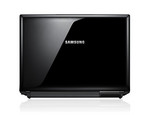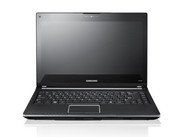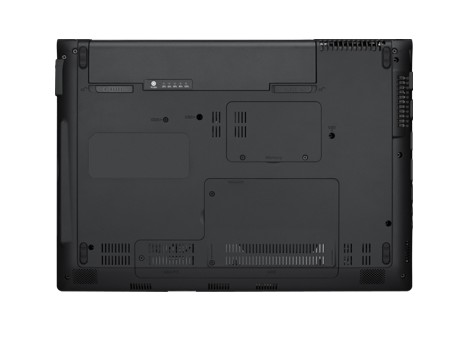Samsung Q320-Aura P8700
Especificaciones de Portátil(es)

Price comparison
Promedio de 10 puntuaciones (de 11 análisis)
Análisis para el Samsung Q320-Aura P8700
Origen: Digital Versus
 EN→ES Archive.org version
EN→ES Archive.org versionAccording to Samsung, the Q320 “is ideal for style-conscious students or power hungry business users who need to keep in touch on the move.” And with its 13.4” display and black shell, the Q320 is indeed a handsome machine. And with a configuration to match, this notebook is a good, relatively mobile all-around partner. Fully equipped and nicely finished, the Samsung Q320 is a good notebook computer if you want to stay away from the bulkiness of the new 15.6” models. Unfortunately its glossy LCD panel is of poor quality, and its sound is very disappointing. Performance is decent and good enough for all-around use
Único Análisis, disponible online, Mediano, Fecha: 10/20/2009
Puntuación: Puntuación total: 80%
Origen: PC Pro
 EN→ES Archive.org version
EN→ES Archive.org versionSamsung's Q320 is a fine example of the increasingly popular 13.3in laptop. It walks the fine line between Apple's minimalism and the attention-seeking gloss of dearer laptops, with the glossy black lid contrasting attractively against a matte-black interior and subtle chrome highlights. Blends portability and finesse with an impressively affordable asking price3
Único Análisis, disponible online, Mediano, Fecha: 10/02/2009
Puntuación: Puntuación total: 100% precio: 100% rendimiento: 83%
Origen: Tech Advisor
 EN→ES Archive.org version
EN→ES Archive.org versionAt £670 the Samsung Q320 poses strong competition for other well-equipped 13in notebooks, such as the Dell Studio XPS 13. Samsung's model has a little more muscle than that, but it isn't quite as stylish. Overall, the NP-Q320 is a pretty good value for a general-purpose laptop. This machine is a bit heavier than most 13in models, but it's compact and lightweight enough to carry around all day at school or work, big enough to work on easily, handsome enough not to walk around with in public, and fast enough to be your primary computer. If the screen were better, the Samsung NP-Q320 would be an outstanding bargain.
Único Análisis, disponible online, Mediano, Fecha: 09/14/2009
Puntuación: Puntuación total: 80%
Origen: PC World
 EN→ES Archive.org version
EN→ES Archive.org versionFor many people, the pricing sweet spot for the perfect laptop is between $800 and $1000. Full-fledged yet svelte, Samsung's NP-Q320 all-purpose notebook ($949 as of September 10, 2009) has the muscle to serve as your primary work/school/home computer. The laptop is compact and light enough (4.8 pounds) not to break your back, it has a 13.4-inch screen that you don't need to squint at, and it's powerful enough to run most major applications well. Still, this nice all-purpose laptop suffers from a couple of minor usability problems.
Único Análisis, disponible online, largo, Fecha: 09/11/2009
Puntuación: Puntuación total: 77% rendimiento: 78% características: 79%
Origen: Laptop Mag
 EN→ES Archive.org version
EN→ES Archive.org versionSamsung’s latest 13-inch notebook offers strong performance for the price, but we’d prefer longer battery life. At first glance, Q320 seems like a bargain, because it is significantly less expensive than 13-inch competitors with discrete graphics, such as the Dell Studio XPS 13 ($1,354) and Sony VAIO SR Series ($1,359). Unfortunately, a hefty frame and short battery life make the notebook less portable than we’d like, and multimedia playback could be better. If you’re willing to sacrifice discrete graphics, the Toshiba Satellite U505 ($799) is $130 cheaper. Nevertheless, if you’re looking for copious processing power and good graphics performance in a 13-inch chassis, the Q320 makes a solid choice at a compelling price.
Único Análisis, disponible online, largo, Fecha: 09/04/2009
Puntuación: Puntuación total: 60%
Origen: Techradar
 EN→ES Archive.org version
EN→ES Archive.org versionSamsung's Q320 is a highly portable laptop offering quality and usability without compromises. If you're in the market for a highly portable laptop, whether it's for business or home use, we're confident you'll struggle to find a better machine than the Samsung Q320. Comfortable, well made and surprisingly powerful, it comes highly recommended.
80
Único Análisis, disponible online, Mediano, Fecha: 06/09/2009
Puntuación: Puntuación total: 80%
Origen: Trusted Reviews
 EN→ES Archive.org version
EN→ES Archive.org versionThis is a well considered and classy step-forward from its predecessor. While the Q310 was overly flashy and slightly gaudy, the Q320 is more restrained and offers a look and feel that surpasses its affordable price. This view can be applied to its feature set and performance as well, making this a stonking bargain that's perfect for anyone who needs a little portability without sacrificing performance.
Único Análisis, disponible online, largo, Fecha: 05/19/2009
Puntuación: Puntuación total: 90% rendimiento: 80% características: 80%
Origen: Notebookcheck
 DE→ES Archive.org version
DE→ES Archive.org versionÚnico Análisis, disponible online, largo, Fecha: 08/20/2009
Puntuación: pantalla: 40% emisiones: 40%
Origen: Minitechnet
 DE→ES Archive.org version
DE→ES Archive.org versionÚnico Análisis, disponible online, largo, Fecha: 07/03/2009
Puntuación: Puntuación total: 80% rendimiento: 80% características: 80% pantalla: 60% movilidad: 80% procesamiento: 100% ergonomía: 100%
Origen: Notebookjournal
 DE→ES Archive.org version
DE→ES Archive.org versionÚnico Análisis, disponible online, largo, Fecha: 04/30/2009
Puntuación: Puntuación total: 80% precio: 70% rendimiento: 60% características: 50% pantalla: 40% movilidad: 70% procesamiento: 90% ergonomía: 70%
Origen: PC World Italia
 IT→ES Archive.org version
IT→ES Archive.org versionÚnico Análisis, disponible online, Mediano, Fecha: 07/21/2009
Puntuación: Puntuación total: 85%
Comentario
NVIDIA GeForce G 105M: Una 9300M GS con mayor velocidad de reloj y por tanto un poco más rápida. Aún fabricada en 65 nm. Soporta Hybrid SLI con HybridPower y GeForceBoost (junto con el chipset Nvidia correcto).
Estos procesadores gráficos pueden mostrar únicamente juegos antiguos, fluidamente. Juegos actuales pueden ser presentados con detalles sustancialmente reducidos.
>> Más información puede ser encontrada en nuestra comparación de tarjetas gráficas moviles y la lista de benchmarks.
Intel Core 2 Duo: Este es el sucesor Core Duo y el Core Solo con un pipeline más largo y con una velocidad entre 5-20% sin mayor consumo de energía. Adicional al diseño de Core Duo existe un cuarto decodificador, una unidad SSE ampliada y una unidad lógica aritmética (ALU) adicional.
Sus características son: 2 núcleos (cores), una amplificación de comando de 64-bit EM64T y 2 o 4 MB L2 Cache y 291 millones de transistores, que son acabados en 65nm. Mas allá de esto, todos los tipos soportan técnicas "Execute Disable Bit", SSSE3 (SSE4), Enhanced Speedstep, LaGrande y la mayoría de técnicas de virtualizacion (VT) Vanderpool.
El Core 2 Duo para laptops es idéntico a los procesadores Core 2 Duo para desktops, pero los procesadores para notebooks trabajan con tensiones más bajas (0.95 a 1188 Volt) y un Frontside bus clock (1066 contra 667 MHz). El rendimiento de laptops cuena con una frecuencia de 20-25% más baja que PCs Desktop debido a una frecuencia más baja de Frontside bus y los discos duros más lentos.
P8700: Procesador de gama media con 3 MB de cache de tercer nivel y un TDP de 25 vatios.
>> Más información puede ser encontrada en nuestra comparación de procesadores móviles.






